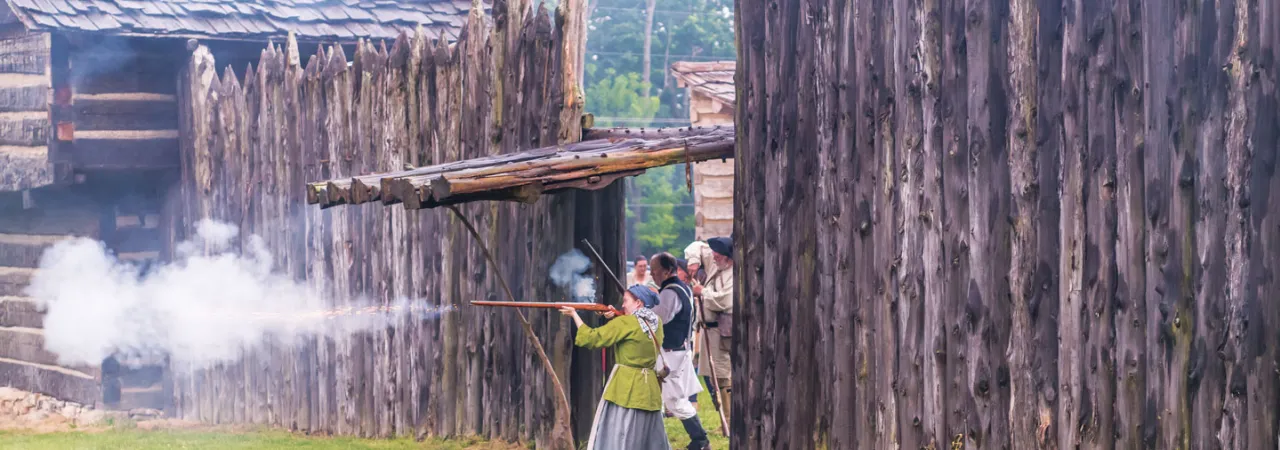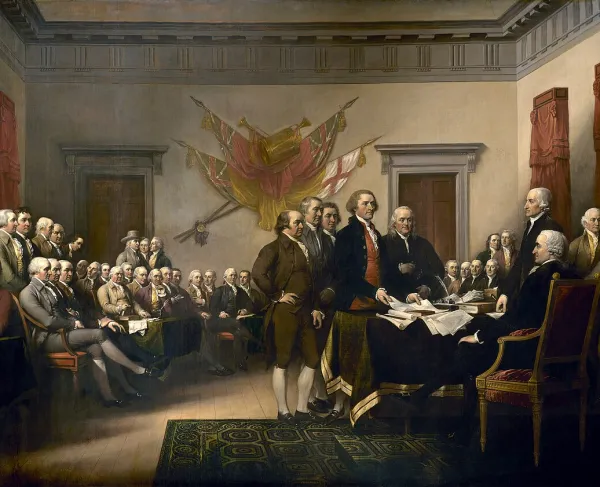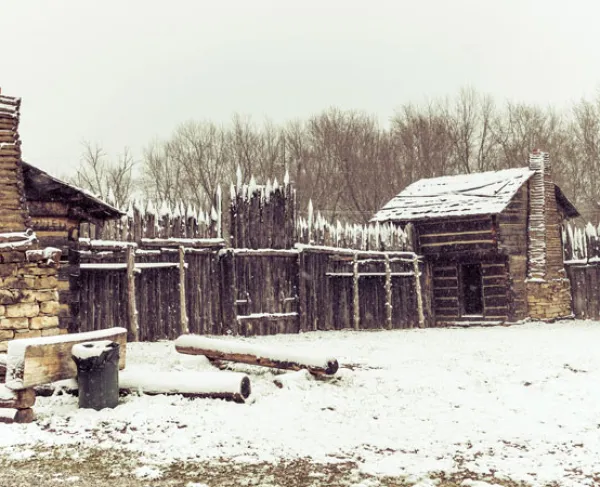
Logan's Fort Park, Stanford, Ky.
For generations, Native Americans utilized the verdant forests, streams, and meadows south of the Ohio River as their hunting grounds. At the conclusion of the French and Indian War, small parties of Long Hunters, colonists who hunted and trapped for a living, pushed into this territory. Sometimes referred to as the “dark and bloody ground”, they called it Kentucky.
In early 1775, Richard Henderson, a North Carolina judge and land speculator negotiated the Treaty of Sycamore Shoals with the Shawnee and Cherokee. In the agreement, Henderson purchased a large swath of land between the Cumberland River and the Ohio. Henderson employed Daniel Boone to cut a trail through the Allegheny Mountains to link the seaboard colonies with new communities he hoped to establish. On April 6, Boone constructed and lent his name to a fort along the Kentucky River, Boonesborough. Thirteen days later in Massachusetts, local militia clashed with Crown forces at Lexington and Concord, igniting the American Revolution.
The flames of rebellion soon spread west. British prosecution of the war fell on the shoulders of Lt. Col. Henry Hamilton, the lieutenant governor at Detroit. Hamilton's main responsibility involved maintaining control of the Ohio River Valley and Canada. With few troops at his disposal, Hamilton depended heavily on alliances with the tribes that inhabited the area around the Great Lakes. By putting pressure on the Americans in Kentucky, Hamilton hoped to divert troops from the colonies and thus weaken the Continental Army.
In March 1777, the Shawnee war chief Blackfish led a force of 200 warriors into Kentucky. Beginning in April, Blackfish struck at Harrodsburg and St. Asaph’s. Rather than launch full scale assaults, the warriors focused their attention on the destruction of crops, animals, and foodstuffs to compel the Americans to abandon Kentucky. Much of their effort centered on Boonesborough. Harassing the fort did not involve the inherent risk of operating against settlements located in the interior as war parties could quickly withdraw to safety north of the Ohio River. Multiple engagements occurred there from April to July. The period ultimately became known as “the year of the bloody sevens”.
With a scant harvest due to the raids, the Americans took to the woods for game. Preservation of the meat required salt, which could be obtained from various buffalo licks. On February 7, 1778, Blackfish captured Boone and a party from Boonesborough while they were boiling salt at the Blue Licks. This loss, however, did not deter a Patriot offensive.
Virginia governor Patrick Henry kept a close eye on the operations in Kentucky. He annexed the territory as a county of Virginia in 1776 and supplied the colonists with munitions. Henry also authorized Col. George Rogers Clark to launch a strike against the Native Americans allied with the British. Clark assembled a force at the Falls of the Ohio in the spring of 1777. He planned to attack the warrior towns in the Illinois Country to relieve the pressure on the Kentucky settlements. Clark set out on his expedition at the end of June. He subsequently captured Cahokia and Kaskaskia, where he spent the winter months. After a grueling 240-mile march, Clark and his men surrounded Hamilton, who planned to launch his own campaign that spring, at Vincennes on February 23, 1779. Unable to endure a siege, Hamilton surrendered three days later.
While Clark operated in Illinois, Boone managed to escape the Shawnee in June 1778 and return to Boonesborough. Blackfish and a small army appeared outside the fort in the second week of September. When truce talks finally broke down, the Shawnees initiated a siege. After twelve days of fighting and unable to capture Boonesborough, Blackfish abandoned the effort. The episode became the longest sustained fight of the war in Kentucky.
Despite Clark’s victories in Illinois, raids continued throughout the summer of 1780, as warriors, accompanied by British officers struck Ruddle’s and Martin’s Station along the Licking River north of Boonesborough. The surrender of Charles, Lord Cornwallis to Gen. George Washington at Yorktown in October 1781 brought an uneasy calm fell to Kentucky. Although the British suspended operations in North America and the belligerent nations entered treaty negotiations, the struggle continued.
In August 1782, British Capt. William Caldwell led a party of Hurons, Shawnee, Wyandot and Mingo warriors, accompanied by elements from Butler’s Rangers into Kentucky. Caldwell briefly attacked Bryan’s Station before withdrawing to the northeast. A militia contingent, including Boone, gave chase. On a ridge near the Blue Licks, Caldwell sprung an ambush which decimated the militia and put them to flight. The battle proved to be the last major engagement in Kentucky as the United States and Great Britain agreed to the Treaty of Paris the following September, bringing an end to the American Revolution.
Related Battles
83
17





